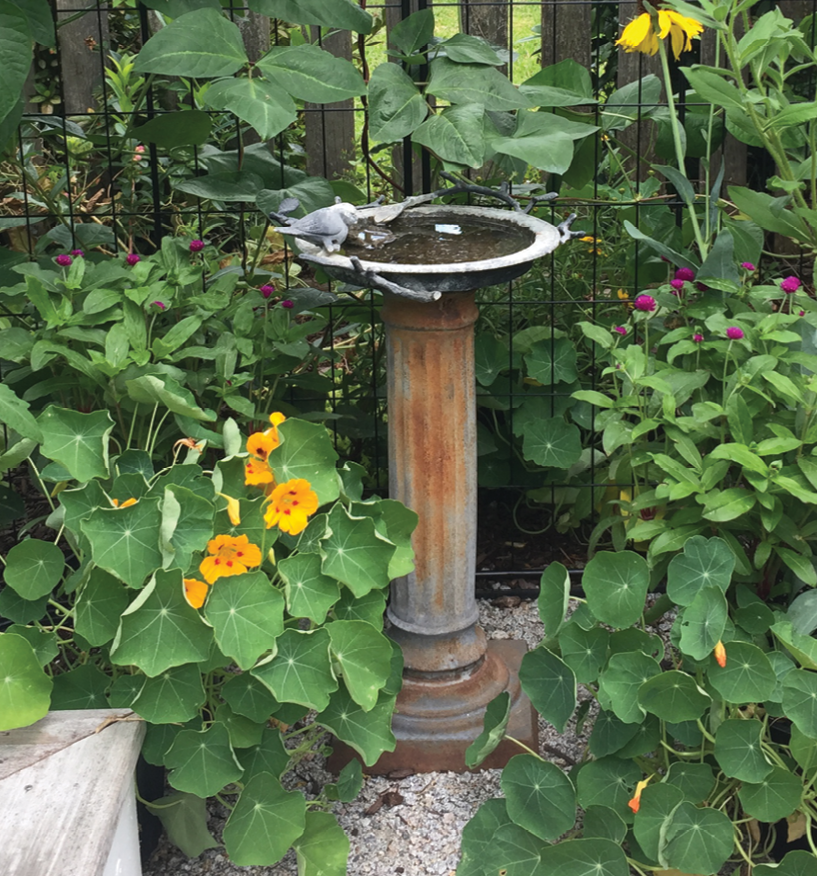Keep your avian neighbors in fine feather with a cool splash spot

Attract more birds to your bath by adding a water feature, such as Wild Birds Unlimited’s “Drip-Or-Mist” attachment ($88). Hummingbirds particularly enjoy refreshing their feathers in a cooling spray.
Everyone’s looking to land waterside these days, including the winged creatures inhabiting our backyard airspace. For the likes of cardinals and chickadees, tufted titmice and Carolina wrens, birdbaths are a valuable oasis—especially during dry spells.
Avian species need fresh water for sipping as well as splashing, explains Jennifer McCarthey Tyrrell, bird-friendly communities coordinator for Audubon South Carolina. “Bathing is important for good feather condition, which is vital to survival, allowing birds to fly and to regulate their body temperature,” she says.
To host a beneficial dipping spot, you need to understand a bit about your clientele. For one thing, “They don’t like water depths of more than an inch and a half,” says Tyrrell. A shallow basin is ideal, but you can make a deeper one more useful by filling it just a little and adding a stone or two for perching.
The animals show preference toward ground-level vessels, which are more like their natural water sources—puddles. You don’t have to spend a lot to deliver: Wild Birds Unlimited (with locations in Mount Pleasant, Summerville, and West Ashley) carries $10 dishes that do the trick. Still, a pedestal-style birdbath will certainly draw customers, and may elevate their theatrics to a more viewable stage.

Charleston garden editor Joan McDonald placed her birdbath at the end of a path.
Shop local garden centers, such as Abide A While, Elizabeth Stuart, Hyams, and The Tree House, for a piece that suits your garden’s style, but keep practical matters in mind. “Concrete baths are porous and have more surface area where grime can stick,” notes Tyrrell. “Glass and porcelain pieces are easier to clean, but if water freezes in them in the winter, they’ll crack.” Metal, plastic, and stone bowls are a breeze to wash and hold up in all weather conditions.
Cleaning your baths once or twice per week is vital because “birds can spread diseases to one another through water,” notes Tyrrell. “Get a good brush and scrub with nine parts water and one part white vinegar, then rinse well.”
Refresh the pool every other day—not only for the sake of feathered visitors, but to prevent mosquitoes from breeding. Better still, incorporate moving water. “Birds love the sound of it,” Tyrrell says. Options range from drippers to solar-powered pumps (invest in one that shuts off automatically when water levels get low).
A well-kept bath should attract plenty of songbirds, and who knows what else. “People have had owls and hawks visit, opossums and raccoons,” says Tyrrell. “The water’s there for everyone who needs it.” Many gardeners—enthralled by the show—include themselves on that list.

(Left) Scarlet sage (Salvia splendens); (right) Purple coneflower (Echinacea purpurea)
Incorporate a birdbath into your landscape with these pro tips